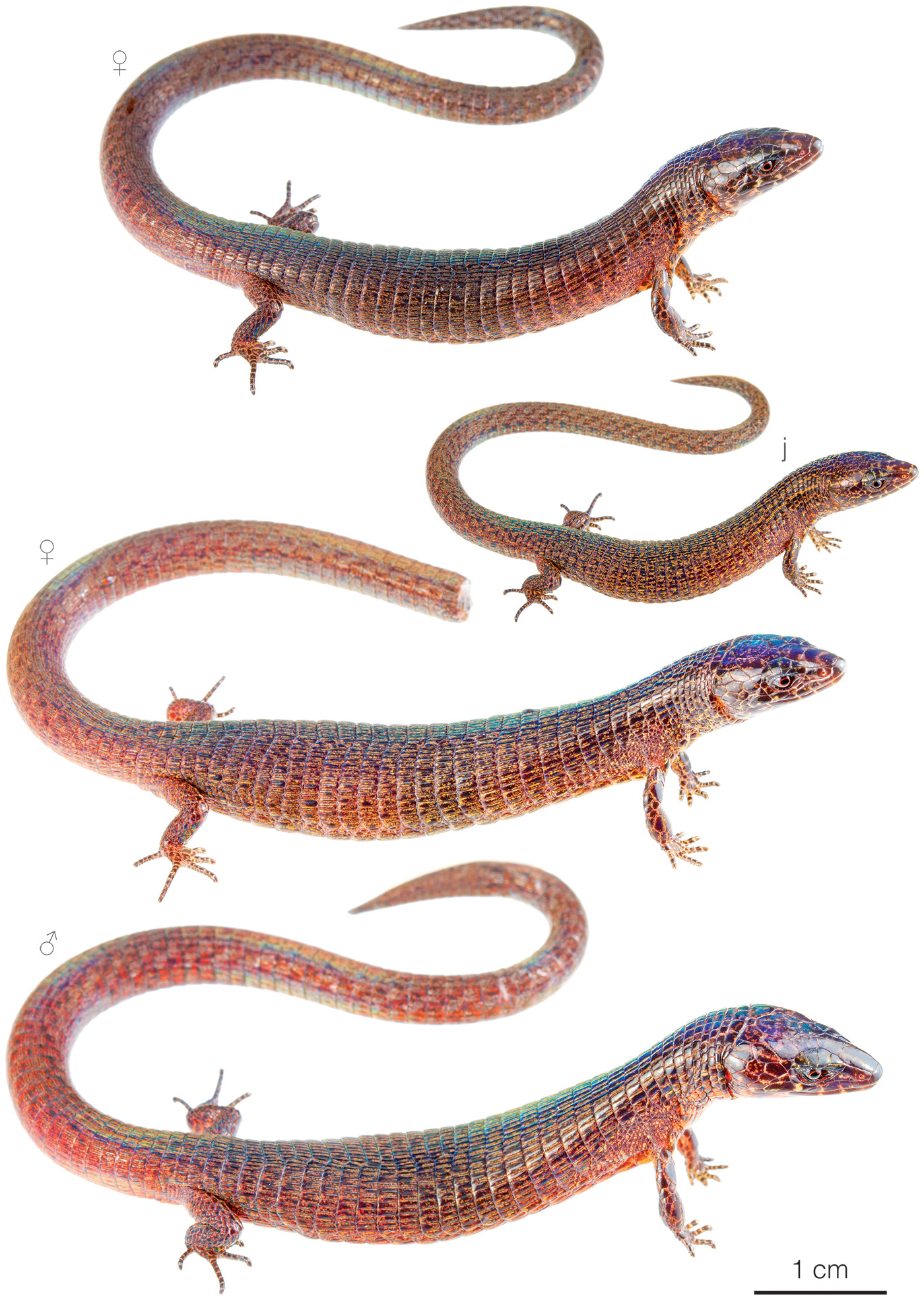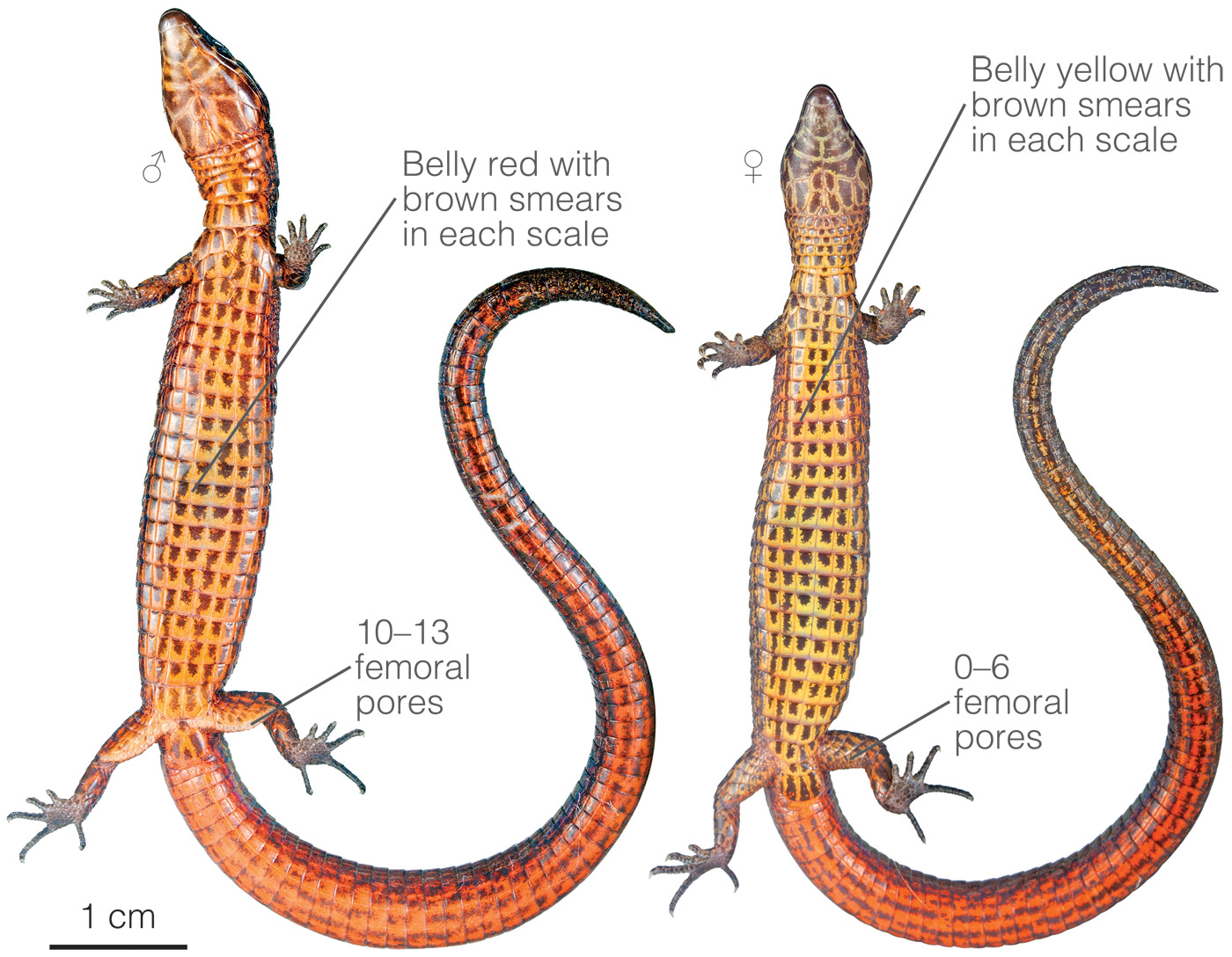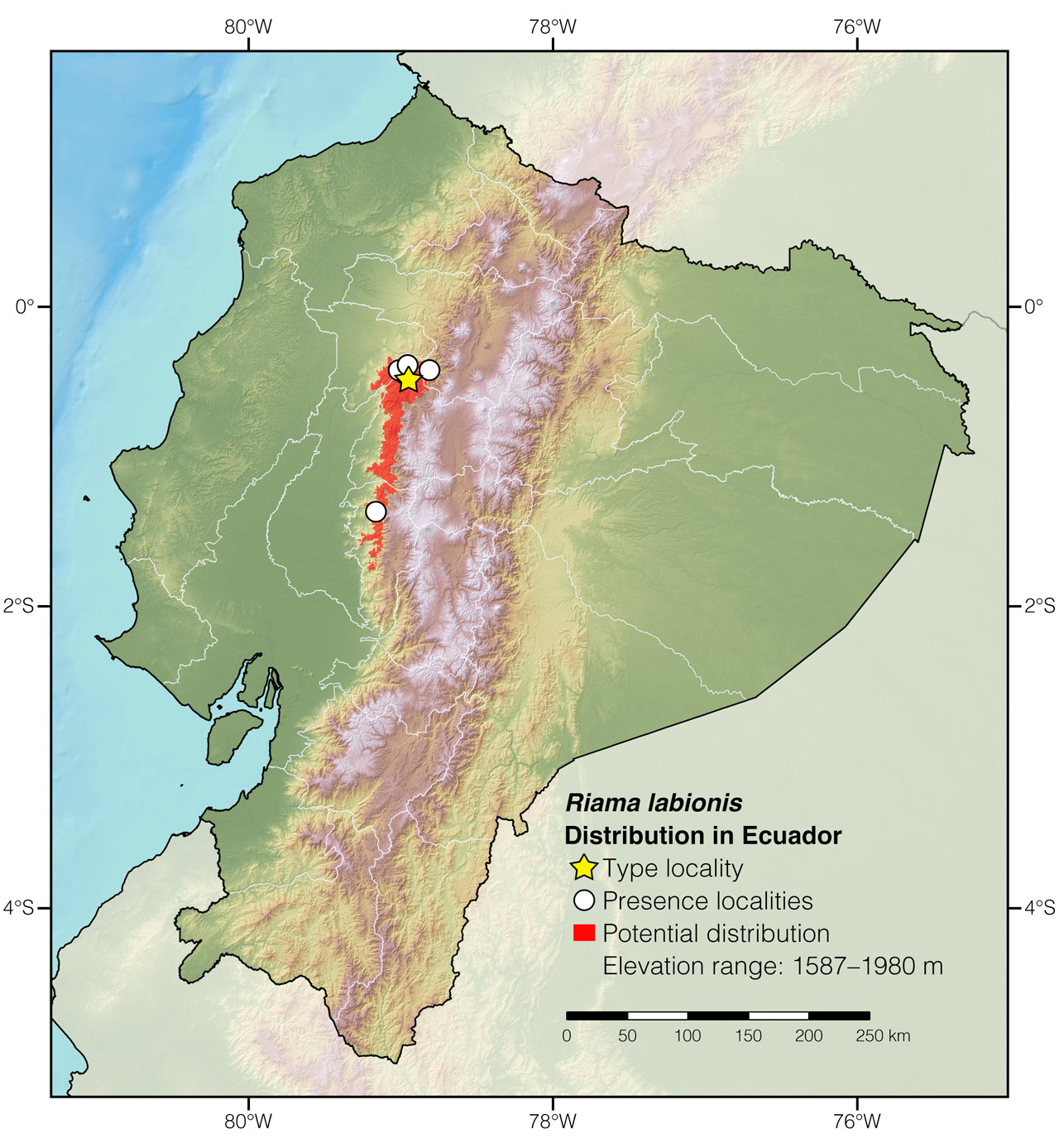Published August 23, 2021. Updated November 30, 2023. Open access. Peer-reviewed. | Purchase book ❯ |
Big-lipped Lightbulb-Lizard (Riama labionis)
Reptiles of Ecuador | Sauria | Gymnophthalmidae | Riama labionis
English common name: Big-lipped Lightbulb-Lizard.
Spanish common name: Lagartija minadora labiosa.
Recognition: ♂♂ 14.9 cmMaximum distance from the snout to the tip of the tail. Snout–vent length=6.0 cm. ♀♀ 15.6 cmMaximum distance from the snout to the tip of the tail. Snout–vent length=5.9 cm..1,2 Lightbulb-lizards are easily distinguishable from other lizards by their fossorial habits and extremities so short that the front and hind limbs cannot reach each other.1,3 In the cloud forests of west central Ecuador, the Riama labionis co-occurs with other microteiid lizards: Andinosaura crypta, A. oculata, and A. vieta.1 From these, it differs by having a yellowish to orange-red belly with brown smears in each scale, shorter limbs, no dorsolateral stripes (Fig. 1), and iris dark brown peripherally becoming orangish centrally, instead of completely bright red.1,2 Males of R. labionis differ from females by having a brighter red ventral coloration and a greater number of femoral pores (Fig. 2).

Figure 1: Individuals of Riama labionis from La Palma, Bolívar province, Ecuador. j=juvenile.

Figure 2: Key morphological differences of the ventral aspect of adult males and females of Riama labionis.
Natural history: Riama labionis is an extremely rare cryptozoic lizard that inhabits old-growth to moderately disturbed evergreen montane forests and cloud forests.1,2 There are no records of this species in pastures or plantations. This reptile has semi-fossorial habits, being found buried in areas having soft soil, abundant leaf-litter, and rotten logs. Individuals have been found 20–50 cm under thick accumulations of leaf-litter in well shaded areas of the forest.2 Females lay clutches of two eggs in soft soil at the base of trees, although more than one clutch may be found in the same nest.2 When threatened, Big-lipped Lightbulb-Lizards flee into leaf-litter. If captured, they may bite or readily shed the tail.2
Conservation: Endangered Considered to be facing a high risk of extinction in the near future..4–6 Riama labionis is listed in this category because the species’ extent of occurrence is small (~2,375 km2; Fig. 3), it occurs as fragmented populations in only five localities (see Appendix 1), and its habitat is declining in extent and quality due to deforestation. Based on maps of Ecuador’s vegetation cover published in 2012,7 the majority (~55%) of the species’ cloud forest habitat has been destroyed, mostly by encroaching human activities such as agriculture, cattle grazing, and the replacement of native vegetation with eucalyptus and pine trees. Although it is estimated that ~41% of the potential distribution of R. labionis overlaps with the Illinizas Ecological Reserve, there are no records of the species there. It has been recorded only in one privately protected area: Otonga Reserve.
Distribution: Riama labionis is endemic to an area of approximately 2,375 km2 in the Pacific slopes of the Andes in central Ecuador. Most records come from the Río Toachi drainage area in the border between provinces Cotopaxi and Pichincha, but a new record from La Palma, Bolívar province (see Appendix 1), extends its distribution 106 km to the south (Fig. 3).

Figure 3: Distribution of Riama labionis in Ecuador. See Appendix 1 for a complete list of the presence localities included in the map.
Etymology: The generic name Riama does not appear to be a reference to any feature of this group of lizards, but a matter of personal taste. John Edward Gray usually selected girls’ names to use on reptiles.8–11 The specific epithet labionis is the genitive singular case of the Latin noun labeo (=large lips),12 and refers to the large supralabial scale, which in this species is fused with the adjacent subocular.1
See it in the wild: Given their secretive habits and extremely small geographic range, Big-lipped Lightbulb-Lizards are not recorded accidentally. The few times these lizards have been located is when they are actively searched for by raking leaf-litter or by turning over rocks and logs in moist, shaded microhabitats. In the lower elevation trails of Otonga Reserve, individuals of Riama labionis have been captured using pitfall traps. In La Palma, Bolívar province, four individuals were found by a party of three people digging in a remnant of native forest during a four hour period.
Acknowledgments: Special thanks to Frank Pichardo and Amadeus Plewnia for their help and companionship during the field trip that resulted in the finding of the individuals of Riama labionis pictured here. This account was published with the support of Secretaría Nacional de Educación Superior Ciencia y Tecnología (programa INEDITA; project: Respuestas a la crisis de biodiversidad: la descripción de especies como herramienta de conservación; No 00110378), Programa de las Naciones Unidas (PNUD), and Universidad San Francisco de Quito (USFQ).
Author and photographer: Alejandro ArteagaaAffiliation: Fundación Khamai, Reserva Arlequín, Ecoruta Paseo del Quinde km 56, Santa Rosa de Mindo, Pichincha 171202, Ecuador.
Academic reviewer: Jeffrey D CamperbAffiliation: Department of Biology, Francis Marion University, Florence, USA.
How to cite? Arteaga A (2023) Big-lipped Lightbulb-Lizard (Riama labionis). In: Arteaga A, Bustamante L, Vieira J (Eds) Reptiles of Ecuador: Life in the middle of the world. Available from: www.reptilesofecuador.com. DOI: 10.47051/YJTL1886
Literature cited:
- Kizirian DA (1996) A review of Ecuadorian Proctoporus (Squamata: Gymnophthalmidae) with descriptions of nine new species. Herpetological Monographs 10: 85–155. DOI: 10.2307/1466981
- Field notes, Reptiles of Ecuador book project.
- Doan TM, Castoe TA (2005) Phylogenetic taxonomy of the Cercosaurini (Squamata: Gymnophthalmidae), with new genera for species of Neusticurus and Proctoporus. Zoological Journal of the Linnean Society 143: 405–416.
- Cisneros-Heredia DF, Yánez-Muñoz M (2017) Riama labionis. The IUCN Red List of threatened species. Available from: www.iucnredlist.org. DOI: 10.2305/IUCN.UK.2017-2.RLTS.T50950517A50950524.en
- Carrillo E, Aldás A, Altamirano M, Ayala F, Cisneros-Heredia DF, Endara A, Márquez C, Morales M, Nogales F, Salvador P, Torres ML, Valencia J, Villamarín F, Yánez-Muñoz M, Zárate P (2005) Lista roja de los reptiles del Ecuador. Fundación Novum Millenium, Quito, 46 pp.
- Reyes-Puig C (2015) Un método integrativo para evaluar el estado de conservación de las especies y su aplicación a los reptiles del Ecuador. MSc thesis, Pontificia Universidad Católica del Ecuador, 73 pp.
- MAE (2012) Línea base de deforestación del Ecuador continental. Ministerio del Ambiente del Ecuador, Quito, 30 pp.
- Gray JE (1831) Description of a new genus of ophisaurean animal, discovered by the late James Hunter in New Holland. Treuttel, Würtz & Co., London, 40 pp.
- Gray JE (1831) A synopsis of the species of the class Reptilia. In: Griffith E, Pidgeon E (Eds) The animal kingdom arranged in conformity with its organization. Whittaker, Treacher, & Co., London, 1–110.
- Gray JE (1838) Catalogue of the slender-tongued saurians, with descriptions of many new genera and species. Annals and Magazine of Natural History 1: 274–283.
- Gray JE (1845) Catalogue of the specimens of lizards in the collection of the British Museum. Trustees of the British Museum, London, 289 pp.
- Brown RW (1956) Composition of scientific words. Smithsonian Books, Washington D.C., 882 pp.
Appendix 1: Locality data used to create the distribution map of Riama labionis in Ecuador (Fig. 2). Go to the section on symbols and abbreviations for a list of acronyms used. Asterisk (*) indicates type locality.
| Country | Province | Locality | Source |
| Ecuador | Bolívar | La Palma, 700 m SW of | This work |
| Ecuador | Cotopaxi | Bosque Integral Otonga | Torres-Carvajal & Salazar-Valenzuela 2012 |
| Ecuador | Cotopaxi | Palo Quemado | Kizirian 1996 |
| Ecuador | Cotopaxi | San Francisco de Las Pampas* | Kizirian 1996 |
| Ecuador | Pichincha | Tandapi | Kizirian 1996 |